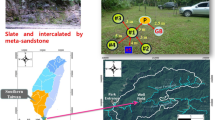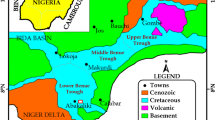Abstract
Information on the role fracture properties plays in groundwater flow and solute transport in crystalline rock masses abound. This study uses the discrete fracture network (DFN) modeling approach from 1128 fractures spanning along 238 m of linear scanline, and 14 circular scanlines to determine mean porosity and permeability of some crystalline rocks in the Togo structural units of south-eastern Ghana. Linear intensity (P10) and areal intensity (P21) were determined, while spatial fracture intensity (P32) and hydraulic properties were estimated from the DFN modeling. The estimated mean porosity is 0.38 for a representative elemental volume of 8000 m3, while the horizontal and vertical permeability values range from 10–3 to 10–4 and 10–4 to 10–6 m/s, respectively. The study concludes that scanline mapping data can be effectively used to project field information at outcrop scales to produce 3D models of discontinuity networks in the crystalline rocks. Results from the study can be of relevance during the siting of waste dumps and water supply sources. The approach would be suitable for the characterization of similar terrains for water resource supply and waste disposal site selection.





Similar content being viewed by others
References
Amadu CC, Foli G, Abanyie S (2017a) Rock fracture characterization for solid waste disposal site selection: a case from sites in the Accra-Tema area, SE Ghana. World J Environ Eng 5(1):7–16. https://doi.org/10.12691/wjee-5-1-2
Amadu CC, Appiah-Adjei EK, Gawu SKY, Rabiu M (2017b) Numerical modeling of contaminant transport in fractured crystalline rocks (FCR) of the Accra-Tema area, South-eastern Ghana. J Sci Technol 37(3):1–14. https://doi.org/10.4314/just.v37i3.1
Anderson MP, Woessner WW (1992) Applied groundwater modeling: simulation of flow and advective transport, Academic Press, San Diego
Arbogast T (1993) Gravitational forces in dual-porosity systems: II. Computational validation of the homogenized model. Transp Porous Media 13(2):205–220. https://doi.org/10.1007/BF00654410
Atobra K (1983) Groundwater Flow in the crystalline rocks of the Accra Plains, West Africa. PhD Thesis, Princeton University, USA
Attoh K (1998) High-pressure granulite facies metamorphism in the Pan-African Dahomeyide orogen, West Africa. J Geol 106(2):236–246. https://doi.org/10.1086/516019
Bear J (1972) Dynamics of fluids in porous media. Am. Elsevier Publishing Co., New York
Benedek K, Dankó G (2009) Stochastic hydrogeological modelling of fractured rocks: a generic case study in the Mórágy Granite Formation (South Hungary). Geol Carpath 60(4):271–281. https://doi.org/10.2478/v10096-009-0019-y
Berkowitz B (2002) Characterizing flow and transport in fractured geologic media: a review. Adv Water Resour 25:861–884. https://doi.org/10.1016/S0309-1708(02)00042-8
Black JH, Robinson PC, Barker JA (2006) A preliminary investigation of the concept of hyper-convergence. Research report R-06-30, Swedish Nuclear Fuel and Waste Management Co., Stockholm
Black JH, Woodman ND, Barker JA (2017) Groundwater flow into underground openings in fractured crystalline rocks: an interpretation based on long channels. Hydrogeol J 25:445–463. https://doi.org/10.1007/s10040-016-1511-y
Boadu FK (2000) Predicting the transport properties of fractured rocks from seismic information: numerical experiments. J Appl Geophys 44(2–3):103–113. https://doi.org/10.1016/S0926-9851(99)00020-8
Cacas MC, Ledoux E, De Marsily GI, Tillie B (1990) Modelling fracture flow with a stochastic discrete fracture network: calibration and validation: 1. Flow Model Water Resour Res 26(3):479–489. https://doi.org/10.1029/WR026i003p00479
Caine JS, Tomusiak SR (2003) Brittle structures and their role in controlling porosity and permeability in a complex Precambrian crystalline-rock aquifer system in the Colorado Rocky Mountain Front Range. GSA Bull 115(11):1410–1424. https://doi.org/10.1130/B25088.1
Darko PK (2001) Quantitative Aspects of Hard Rock Aquifers: Regional Evaluation of Groundwater Resources in Ghana. Ph.D. Thesis, Charles University, Prague, Czech Republic
Darko PK, Krasny J (2003) Regional transmissivity distribution and groundwater potential in hard rocks of Ghana. In: Krasny J, Hrkal Z, Bruthans J (eds) Proceedings of IAH International Conference on ground water in fractured rocks. IHP-VI Series on groundwater, No 7. Praque, Czech Republic, pp 15–19
Davy P, Bour O, De Dreuzy JR, Darcel C (2006) Flow in multiscale fractal fracture networks. In: Cello G, Malamud BD (eds) Fractal Analysis for Natural Hazards. Geological Society, London, Special Publications, pp 261, 31–45. 0305-8719/06/$15.00
DEP (2004) Department of Environmental Protection: Use of MNA for groundwater remediation: contaminated sites management series. www.environ.wa.gov.au. Accessed 26 Aug 2019
Dershowitz W, Thomas A, Busse R (1996) Discrete fracture analysis in support of the Aspo tracer retention understanding experiment (TRUE-1). SKB International Cooperation Report ICR-96-05 Swedish Nuclear Fuel and Waste Management Co., Stockholm, Sweden
Dershowitz W, Lee G, Geier J, LaPointe PR (1998) FracMan: interactive discrete feature data analysis, geometric modeling and exploration simulation. User documentation. Golder Associates Inc., Seattle
Dershowitz WS, Lee G, Geier J, Foxford T, LaPointe P, Thomas A (2004) FracMan interactive discrete feature data analysis, geometric modelling, and exploration simulation. User documentation, Golder Associates Inc, Seattle
Dickson KB, Benneh G, Essah RR (1988) A new geography of Ghana (vol 34). Longman, London
Dowd PA, Martin JA, Xu C, Fowell RJ, Mardia KV (2009) A three-dimensional fracture network data set for a block of granite. Int J Rock Mech Min Sci 46(5):811–818. https://doi.org/10.1016/j.ijrmms.2009.02.001
Elmo D, Stead D (2010) An integrated numerical modelling-discrete fracture network approach applied to the characterization of rock mass strength of naturally fractured pillars. Rock Mech Rock Eng 43:3–19. https://doi.org/10.1007/s00603-009-0027-3
Elmouttie M, Poropat G, Krähenbühl G (2010) Polyhedral modelling of underground excavations. Comput Geotech 37(4):529–535. https://doi.org/10.1016/j.compgeo.2010.02.009
Garzonio CA, Piccinini L, Gargini A (2014) Groundwater modelling of fractured aquifers in mines: the case study of Gavorrano (Tuscany, Italy). Rock Mech and Rock Eng 47(3):905–921. https://doi.org/10.1007/s00603-013-0444-1
Ghasemizadeh R, Hellweger F, Butscher C, Padilla I, Vesper D, Field M, Alshawabkeh A (2012) Review: groundwater flow and transport modeling of karst aquifers, with particular reference to the North Coast Limestone aquifer system of Puerto Rico. Hydrogeol J 20(8):1441–1461. https://doi.org/10.1007/s10040-012-0897-4
Hagagg KH (2018) Numerical modeling of seawater intrusion in karstic aquifer, Northwestern Coast of Egypt. Model Earth Syst Environ. https://doi.org/10.1007/s40808-018-0549-3
Hamblin WK, Christiansen EH (2004) Earth’s dynamic systems, 10th edn. Prentice-Hall, Upper Saddle River
Hartley L, Cox I, Holton D, Hunter F, Joyce S, Gylling B, Lindgren M (2004) Goundwater flow and radionuclide transport modeling using CONNECTFLOW in support of the SR Can assessment, Rep. R‐04‐61, Swed. Nucl. Fuel and Waste Manage. Co., Stockholm
Hirdes W, Toloczyki M, Davis DW, Agyei-Duodu J, Loh GK, Boamah K, Baba M (2009) Geological map of Ghana 1:1,000,000. Geological Survey Department, Accra, Ghana (GSD) and Bundesanstalt für Geowissenschaften und Rohstoffe, Hannover, Germany (BGR). BGR Library No. 2010 B 267
Hornung U (1997) Homogenization and porous media, interdisciplinary applied mathematics, 6th edn. Springer, New York
Illman WAX, Liu S, Takeuchi TC, Yeh J, Ando K, Saegusa H (2009) Hydraulic tomography in fractured granite: Mizunami underground research site, Japan. Water Resour Res. https://doi.org/10.1029/2007WR006715
Johntson PB, Atkinson T, Baker J (2009) Constraining the uncertainty in fracture geometry using tracer tests. Hydrogeol J 17:527–539. https://doi.org/10.1007/s10040-008-0378-y
Khodaei M, Delijani EB, Hajipour M, Karroubi K, Dehghan AN (2020) On dispersion of stress state and variability in fractured media: effect of fracture scattering. Model Earth Syst Environ. https://doi.org/10.1007/s40808-020-01046-8
Klimczak C, Schultz RA, Parashar R, Reeves DM (2010) Cubic law with aperture-length correlation: implications for network scale fluid flow. Hydrogeol J 18(4):851–862. https://doi.org/10.1007/s10040-009-0572-6
Kuma JS, Ashley DN (2008) Runoff estimates into the Weija Reservoir and its implications for water supply to Accra, Ghana. J Urban Environ Eng 2(2):33–40
Lambert C, Read J (2010) Sensitivities in rock mass properties: a DEM insight: University of Canterbury research repository. http://hdl.handle.net/10092/8380. Accessed 8 Mar 2019
Lee I, Ni CF, Lin FP, Lin CP, Ke CC (2019) Stochastic modeling of flow and conservative transport in three-dimensional discrete fracture networks. Hydrol Earth Syst Sci 23:19–34
Leube A, Hirdes W, Mauer R, Kesse GO (1990) The early Proterozoic Birimian Supergroup of Ghana and some aspects of its associated gold mineralization. Precambrian Res 46(1–2):139–165. https://doi.org/10.1016/0301-9268(90)90070-7
Lyman GJ (2003) Rock fracture mean trace length estimation and confidence interval calculation using maximum likelihood methods. Int J Rock Mech Min Sci 40(6):825–832. https://doi.org/10.1016/S1365-1609(03)00043-1
Mauldon M, Dunne WM, Rohrbaugh MB Jr (2001) Circular scanlines and circular windows: new tools for characterizing the geometry of fracture traces. J Struct Geol 23(2–3):247–258. https://doi.org/10.1016/S0191-8141(00)00094-8
Mokarram M (2016) Modeling of multiple regression and multiple linear regressions for prediction of groundwater quality (case study: north of Shiraz). Model Earth Syst Environ 2:3. https://doi.org/10.1007/s40808-015-0059-5
Muff R, Efa E (2006) Explanatory notes for the coastal stability map 1: 100,000 for Greater Accra Metropolitan Area, 18
Myers DE (1994) Statistical methods for interpolating spatial data. J Appl Sci Comput 1(2):283–318
Newell CJ, Aziz JJ, Vanderford M (2007) Appendix A.2: Statistical trend analysis methods. http://www.gsi-net.com/en/software/free-software/. Accessed 19 May 2019
Odling NE, Roden JE (1997) Contaminant transport in fractured rocks with significant matrix permeability, using natural fracture geometries. J Contam Hydrol 27:263–283. https://doi.org/10.1016/S0169-7722(96)00096-4
Olson JE (2003) Sublinear scaling of fracture aperture versus length: an exception or the rule? J Geophys Res Solid Earth. https://doi.org/10.1029/2001JB000419
Omotola OO, Oladapo MI, Akintorinwa OJ (2020) Modeling assessment of groundwater vulnerability to contamination risk in a typical basement terrain case of vulnerability techniques application comparison study. Model Earth Syst Environ. https://doi.org/10.1007/s40808-020-00720-1
Pahl PJ (1981) Estimating the mean length of discontinuity traces. Int J Rock Mech Min Sci Geomech Abstr 18:221–228
Parker BL, Cherry JA, Chapman SW (2012) Discrete fracture network approach for studying contamination in fractured rock. AQUA Mundi 3(2):101–116. https://doi.org/10.4409/Am052-12-0046
Priest SD (1993) Discontinuity analysis for rock engineering. Chapman & Hall, London
Riley MS, Ward RS, Greswell RB (2001) Converging flow tracer tests in fissured limestone. Q J Eng Geol 34:283–297
Rogers S, Elmo D, Webb G, Catalan A (2015) Volumetric fracture intensity measurement for improved rock mass characterization and fragmentation assessment in block caving operations. Rock Mech Rock Eng 48:633–649. https://doi.org/10.1007/s00603-014-0592-y
Rohrbaugh MB Jr, Dunne WM, Mauldon M (2002) Estimating fracture trace intensity, density, and mean length using circular scan lines and windows. Am Assoc Pet Geol Bull 86(12):2087–2102. https://doi.org/10.1306/61EEDE0E-173E-11D7-8645000102C1865D
Scholz CH (2010) A note on the scaling relations for opening mode fractures in rock. J Struct Geol 32:1485–1487. https://doi.org/10.1016/j.jsg.2010.09.007
Selroos JO, Walker DD, Ström A, Gylling B, Follin S (2002) Comparison of alternative modelling approaches for groundwater flow in fractured rock. J Hydrol 257(1–4):174–188. https://doi.org/10.1016/S0022-1694(01)00551-0
Singhal BBS, Gupta RP (1999) Applied hydrogeology of fracture rocks. Kluwer, Dordrecht, pp 166–167
Sircar A, Thander B, Yadav K (2020) Stochastic modeling of earth’s hydrocarbon resources using artificial neural network. Earth Syst Environ Model. https://doi.org/10.1007/s40808-020-00880-0
Tartar L (1980) Incompressible fluid flow in a porous medium—convergence of the homogenization process. In: Sanchez-Palencia E (ed) Lect Notes Physics, vol 127. Springer, New York, pp 368–377
Tchalenko JS (1970) Similarities between shear zones of different magnitudes. Geol Soc Am Bull 81:1625–1640
Van Duijn CJ, Mikelić A, Pop IS, Rosier C (2008) Effective dispersion equations for reactive flows with dominant Peclet and Damkohler numbers. Adv Chem Eng 34:1–45. https://doi.org/10.1016/S0065-2377(08)00001-X
Vermilye JM, Scholz CH (1995) Relation between vein length and aperture. J Struct Geol 17(3):423–434. https://doi.org/10.1016/0191-8141(94)00058-8
Voeckler H, Allen DM (2012) Estimating regional scale fractured bedrock hydraulic conductivity using a discrete fracture network (DFN) modelling. Hydrogeol J 20:1081–1100. https://doi.org/10.1007/s10040-012-0858-y
Yidana SM, Ganyaglo S, Banoeng-Yakubo B, Akabzaa T (2011) A conceptual framework of groundwater flow in some crystalline aquifers in Southeastern Ghana. J Afr Earth Sci 59(2–3):185–194. https://doi.org/10.1016/j.jafrearsci.2010.10.005
Zhang X, Sanderson DJ (1999) Scale up of two-dimensional conductivity tensor for heterogeneous fracture networks. Eng Geol 53:83–99. https://doi.org/10.1016/S0013-7952(98)00082-9
Zhang X, Sanderson DJ, Harkness RM, Last NC (1996) Evaluation of the 2-D permeability tensor of fractured rock. Int J Rock Mech Min Sci 33:17–37. https://doi.org/10.1016/0148-9062(95)00042-9
Author information
Authors and Affiliations
Corresponding author
Additional information
Publisher's Note
Springer Nature remains neutral with regard to jurisdictional claims in published maps and institutional affiliations.
Rights and permissions
About this article
Cite this article
Amadu, C.C., Awotwi, A., Foli, G. et al. Rock fracture characterization and discrete network modeling and its implication for groundwater flow in crystalline rocks of south-eastern Ghana. Model. Earth Syst. Environ. 8, 991–1001 (2022). https://doi.org/10.1007/s40808-021-01139-y
Received:
Accepted:
Published:
Issue Date:
DOI: https://doi.org/10.1007/s40808-021-01139-y




